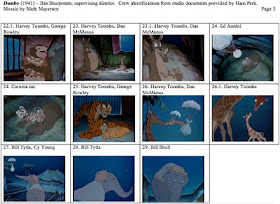



 After the emotional confrontation over Dumbo's ears in the last sequence, the film takes things down a notch by following Casey Jr. as he pulls into town. There's an explicit quote from The Little Engine that Could here.
After the emotional confrontation over Dumbo's ears in the last sequence, the film takes things down a notch by following Casey Jr. as he pulls into town. There's an explicit quote from The Little Engine that Could here.What follows is one of the most interesting sequences in Disney history, and one thing that makes it interesting is how little discussion it has provoked. While the crows later in the film have been the subject of much debate, the racial overtones of this sequence seem to have escaped notice.
Why is this sequence in the film at all? What follows it is a circle wipe to the circus parading down main street. That could easily have followed Casey Jr. pulling into town. There's a bit of humor in this sequence with Dumbo trying and failing to do the work of the older elephants, but the gags are generic, doing nothing to give us a better idea of who Dumbo is as an individual. This sequence seems to be here to make a comment on race and class. That's relatively unusual for a Disney film (though it does pop up in shorts like Who Killed Cock Robin?). This is the first Disney feature to be set in contemporary times, so this sequence is a reflection of what was on the artists' minds.
The only humans we've seen previously are in sequence 3. They are all white and wearing uniforms that clearly mark them as circus employees. When we get to this sequence, the only humans we see are black. As they are disembarking from a railroad car, we know that they are also employees, but they don't get uniforms. The roustabouts are the ones who do the heavy lifting, regardless of the weather. Why aren't the rest of the employees helping? I guess the work is beneath them. Let's not forget that the circus wintered in Florida, at the time a Jim Crow state.
The lyrics of the song are worth noting:
Hike! Ugh! Hike! Ugh! Hike! Ugh! Hike!
We work all day, we work all night
We never learned to read or write
We're happy-hearted roustabouts
Hike! Ugh! Hike! Ugh! Hike! Ugh! Hike!
When other folks have gone to bed
We slave until we're almost dead
We're happy-hearted roustabouts
Hike! Ugh! Hike! Ugh! Hike! Ugh! Hike!
We don't know when we get our pay
And when we do, we throw our pay away
(When we get our pay, we throw our money all away)
We get our pay when children say
With happy hearts, "It's circus day today"
(Then we get our pay, just watching kids on circus day)
Muscles achin'
Back near breaking
Eggs and bacon what we need (Yes, sir!)
Boss man houndin'
Keep on poundin'
For your bed and feed
There ain't no let up
Must get set up
Pull that canvas! Drive that stake!
Want to doze off
Get them clothes off
But must keep awake
Hep! Heave! Hep! Heave! Hep! Heave!
Hep! Heave! Hep! Heave! Hep! Heave!
Hep! Heave! Hep!
Swing that sledge! Sing that song!
Work and laugh the whole night long
You happy-hearted roustabouts!
Pullin', poundin', tryin', groundin'
Big top roundin' into shape
Keep on working!
Stop that shirking!
Grab that rope, you hairy ape!
Poundin'! poundin'! poundin'! poundin'!
Oh...
Note the use of the word "slave." Note also that they are illiterate and aren't paid on a regular basis. Happy-hearted? The visuals and the rest of the lyrics seem to dispute that. The song is nothing less than an extension of work songs sung in the fields by black slaves to dull the strain and boredom of work. Once this sequence is over, the roustabouts vanish from the film.
There's also an explicit parallel drawn between the elephants and the black workers. Except for one shot with camels, it appears that the elephants are the only circus animals helping to set up the big top. Shots 25 and 26 explicitly show the tigers lounging in their cage while the elephants exert themselves.
While the film is ostensibly about Dumbo, a freak who is persecuted, this sequence makes it clear that Dumbo is just an extreme case of an ongoing problem. Everyone in this film is judged on the basis of appearance, not as an individual.
One of the most interesting things to me about the early Disney features is how dangerous the environments are for the characters. We're living in a time now when entertainment is routinely made bland to protect children from upset. In 1940, the audience had weathered the greatest economic reversal in memory and was warily following a European war. The audience didn't have to be reminded that life was hard, dangerous and unfair.
Animation-wise, shot 22 by Hugh Fraser has Dumbo descending from the railroad car on a vibrating gangplank. The animation doesn't really work as Dumbo comes off as weightless. I'm sure that a higher budget would have caused the scene to be revised.
Jack Campbell's work on the roustabouts is excellent. Despite the fact that they have no faces, they do have a real presence. You can feel their exertion.
Steve Bosustow, later the head of UPA, has several shots of elephants here.
The effects animation in this sequence is excellent. The rain is well done and Disney always makes it a point to show the drops hitting surfaces. Cheaper animation generally just overlays the rain on the scene without showing the drops making contact with anything. The use of rim lighting on the elephants and the roustabouts is beautiful and the use of aerial perspective on shots like 57 and 57.1 adds a tremendous sense of depth.



















